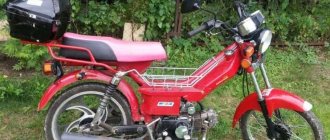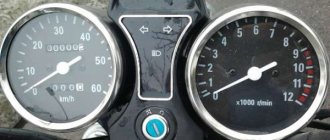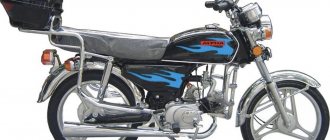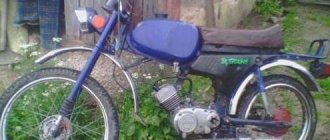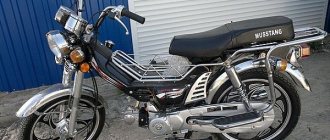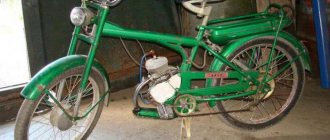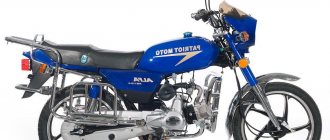In the post-Soviet space, the Karpaty moped is one of the most popular small vehicles on two wheels. Compared to similar units, the device in question was distinguished by good quality, practicality and original design. Among the features, it is necessary to note the three-block type clutch. The two-speed gearbox provided a fairly good smooth start and maximum speed (45-50 km/h).
Peculiarities
Despite the fact that it was almost impossible to somehow tune the unit, its ease of maintenance and the ability to independently repair absolutely all units certainly played a key role in its popularity. Original spare parts for the Karpaty moped were made of high-quality metal, although the equipment of that time often broke down due to design and technical flaws.
The trunk of the vehicle in question could withstand more than one hundredweight of cargo. The tires had a high tread, which made it possible to operate the equipment in winter. Drum brakes were quite enough for the weight and dynamics of the small motorcycle. The power unit itself is a regular two-stroke engine. Almost every owner of this representative of motorcycle equipment can replace the rings or piston.
Notes[edit | edit code]
- ↑ Mopeds “Verkhovyna” and “Karpaty” (unspecified)
. Access date: March 9, 2011. - ↑ Evseev D.
Mokiki “Carpathians-2”, “Delta”. - RusAvtokniga, 2002. - 64 p. — (“Rocker”). — ISBN 5942280452. - ↑ 1234
Mopeds, mokicks. Design, maintenance, repair / comp. Bykov K. P., Grishchenko P. V., eds. Shlenchik T. A. - Chernigov: PKF Ranok, 2004. - 128 p. - (Soviet motorcycles). — ISBN 966-8185-04-8. - ↑ Mokik “Carpathians” (undefined)
. Access date: March 8, 2011. - ↑ 1 2 3
Mokik “Karpaty-2”, “Karpaty-2 Lux”, “Karpaty-2 Sport”
(unspecified)
. Access date: March 8, 2011. - ↑ "Karpaty-Sport" (undefined)
. Behind the wheel (November 1, 1984). Date accessed: January 3, 2022. - ↑ Mopeds of the Soviet era (unspecified)
. Access date: March 8, 2011. Archived July 22, 2012.
Competitors
The unit received the closest competitor in terms of characteristics in the “face” of the Verkhovyna vehicle. The Karpaty moped's ignition, clutch assembly, design and some other indicators were significantly superior to its rival. In addition, “Delta” and “Verkhovyna-7” competed with the vehicle in question. Although all components of these variations were modernized, preference was given to the “Carpathians”.
There are several reasons for this. Firstly, the price of the Delta was higher, and it was produced in Riga. Secondly, the improved Verkhovyna had a guaranteed mileage of 6,000 kilometers, and a service life before major repairs of 15 thousand. The Karpaty moped at the same time had eight and eighteen thousand, respectively.
More than one generation, especially in rural areas, has studied every cog in this unit. A brief overview of the location of the main elements:
- The air filter is located directly behind the carburetor.
- The gearshift control lever is on the left, the brakes on the right.
- Also on the steering wheel is the clutch handle, gas, and front brake.
It is worth noting that there is no electric starter, so a fairly popular way to start the engine was to activate it with a “push” or “claw”.
Crankshaft
The crankshaft was loose and needed to be replaced with a new one or just the connecting rod.
The threads for some of the bolts were torn off and to prevent the bolts from falling out, someone flattened them and hammered them in with a hammer. We did the same with the drain plug.
By and large, there is nothing more to say about this engine. In addition to these, there are many more jambs in it, and the site’s resources are not unlimited, so, perhaps, I’ll summarize.
I took all this junk apart, washed it, rejected the parts and made a list of what I needed to buy. And then incomprehensible conversations began, which I really don’t like: they say, “you repair it.” — What about spare parts? “Yes, you understand, there’s no money now, it’s a lot of money” (...)
I waited, I waited for the financial tranche, but it never came. I collected these shakes in a bag, threw them into the cradle and sent this “Karpacz” back to where he came to me from.
Nuances of repair work
Almost every owner could repair the Karpaty moped independently. Quite often it was necessary to rebuild the engine. No matter how difficult this work may seem, thanks to the simple design of the motor of the unit in question, everything could be done quickly and efficiently.
If the cause of the breakdown is the failure of the bearings, crankshaft, rings, the engine will need to be split. This is a relatively simple procedure, much more difficult to put everything back together correctly. Although, if you pay close attention to the process and recommendations in the instructions, everything is very real.
Gaskets for the muffler can be cut out of thick cardboard and lubricated with grease. Important: when tightening the nuts, it is necessary to maintain the optimal force, avoiding insufficient fastening or stripping the threads. The Karpaty moped runs on a mixture of gasoline and oil; there is no special oil receiver. The optimal fuel is AI-80.
How did the boys buy such equipment?
The Karpaty moped cost from 220 to 260 rubles, depending on the modification and year of manufacture. Towards the end of the 80s the price gradually increased. In the city, teenagers could rarely afford to buy such equipment new. But in the villages there were no problems with this - there the boys made money in the summer on the collective farm, or by selling forest products.
One of the last Carpathian mopeds from the 90s. Photo: Youtube.com
In the city they usually bought a very used moped, and it cost 100-150 rubles. The acquisition of new equipment was considered a sign of a lack of “direct hands” and people were jealous, calling the happy owner a mama’s boy.
The most profitable option was to buy a moped together for 20-50 rubles, disassembled or incomplete. Then the equipment was repaired in the yard through joint efforts. Adult men of different ages helped the guys with repairs, and everything was done for free. Often a compassionate driver would find a moped engine in the garage and give it to the kids. Another could do it with a frame on wheels. Those were emotional times, and the drivers always helped each other.
The finished unit was then modified to the best of our abilities and capabilities, according to yard fashion trends. The steering wheel was increased in size and a jumper was placed on it. Not everyone realized that this strengthened the structure, but in the USSR there were plenty of guys involved in motocross. Those whose parents or brothers worked as turners in factories could order new footrests and handles of the original look from them. The spokes were intertwined with wire, and fur and fringe were attached to the steering wheel.
Specifications
What technical parameters does the Karpaty moped have? Characteristics of the main components are presented below:
- Full weight - 55 kg.
- Maximum load - 100 kg.
- Base - 1.2 m.
- Length/height/width - 1.8/1.1/0.7 m.
- Clearance - 10 cm.
- The maximum speed limit according to the passport is up to 45 km/h.
- Fuel consumption per hundred is 2.1 liters.
- Frame type - construction based on welding of a tubular sample.
- The front suspension unit is a telescopic fork, spring shock absorbers.
- The rear suspension is shock-absorbing springs with a pendulum.
- The total braking distance at 30 km/h is 7.6 m.
- Tire categories - 2.50-16 or 2.75-16 inches.
- The power unit is a V-50 carburetor, two strokes, air cooling.
- Volume - 49.9 cubic meters. cm.
- Cylinder size: 3.8 cm.
- Piston stroke - 4.4 cm.
- Compression ratios range from 7 to 8.5.
- Motor power - 1.5 l. With.
- Maximum torque – 5200 rpm.
- Transmission - two stages, manual or similar with foot switch.
Engine design V-50
Šiauliai Bicycle Motor Plant began production of a new V-50 engine with a displacement of 49.8 cm3.
It is intended for mokiks “Riga” and “Karpaty” (“Behind the wheel”, 1982, no. 7). In terms of power and economic parameters, the V-50 does not differ from the previous models Sh-62 (“Behind the Wheel”, 1983, No. 1) and Sh-62M. Power is 1.6-2.0 liters. With. at 4800-5200 rpm. However, serious improvements have been made to the design, which have significantly improved the consumer qualities of the engine, in particular operational reliability. Almost all main components and parts have undergone changes. Thus, in the gearbox the interaxal distance of the shafts has been increased, the gears are stronger than steel, and rolling bearings are used instead of plain bearings. The clutch now has three plastic discs. Its inner drum and the bearing of the lower head of the connecting rod became more reliable (thanks to the use of rollers with a diameter of 4 mm and a length of 8 mm). In addition, the diameter of the piston pin has been increased, which has a beneficial effect on the durability of the bushing in the upper head of the connecting rod, and in the future makes it possible to use needle bearings.
All these innovations aimed at increasing reliability naturally exclude the interchangeability of many parts between the Sh-62M and V-50 engines. However, when assembled, the latter can be installed instead of the previous Sh-62M and Sh-62 motors. Many of the parts most often replaced during maintenance and minor repairs remained unchanged. These are gaskets and seals, piston rings, parts of the clutch release mechanism, exhaust and intake systems, plastic clutch discs. In addition, the cylinder and its head, carburetor, and electrical equipment are interchangeable with the old model.
The new engine is started by a kick starter and is linked to a two-speed gearbox with manual shifting.
The engine is designed for use as a base model for various modifications. Work is nearing completion on the creation of options with foot gear shifting, with liquid and forced cooling, as well as with a check plate valve at the inlet. In the near future, these modifications will be mass-produced.
D. SHISHKOVETS, chief designer J. PLOTKIN, engineer of Siauliai
Engine design V-50:
1 - cylinder head; 2 - cylinder; 3 — left half of the crankcase; 4 — left crankcase cover; 5 — clutch; 6 — clutch release mechanism; 7 — drive gear (1} teeth); 8 — gear block (12 and 17 teeth); 9 — driven gear (57 teeth); 18 — secondary shaft; 11 — first gear gear |25 teeth); 12 — starting lever; 13 — kick starter spring; 14 — emphasis; 15 - sealing ring; 16 — trigger gear (24 teeth); 17 — ratchet clutch; 18 — ratchet clutch spring; 19 — shift clutch; 20 — kick starter shaft; 21 — second gear gear (20 teeth); 22 — leading leash; 23 — driven leash; 24 — speedometer drive gear (13 teeth); 25 — speedometer driven gear (18 teeth); 26 — driving chain sprocket (15 teeth); 27 - crankshaft; 28 - generator; 29 — right crankcase cover; 30 - right half of the crankcase; 31 — connecting rod; 32 — piston pin; 33 - piston ring; 34 - piston; 35 - spark plug.
1984N05P8
Other parameters
Other characteristics that the Karpaty moped has are as follows:
- Electrical equipment - contactless electronic ignition system with alternator.
- Transmission - multi-disc clutch.
- Fuel capacity - 7 liters.
- The motor transmission ratio is 4.75.
- The same ratio from the gearbox to the rear wheel is 2.2.
- Carburetor type - K60V.
- The energy supplier is a 6 V AC generator with a power of 45 W.
- The filter element is air type with a paper filter.
- Gas exhaust - a muffler with partitions for throttling the exhaust.
- The fuel mixture is A-76-80 gasoline with oil (ratio - 100:4).
The clutch of the Karpaty moped was an innovative solution at that time. This is a three-block or multi-disc type unit. For low-power two-wheeled vehicles, such a design was a novelty.
How much does it cost now?
A Mokik from the Lvov Motorcycle Plant can now be purchased for 15-30 thousand rubles.
Equipment for this amount will be very battered by life, but closer to the very top price range it gets better. However, there is not much to choose from; there are rarely more than 5 copies on sale. Some restore old equipment, others introduce more modern engines from Chinese models into the frame.
Mopeds were produced in different colors. Photo: Youtube.com
The Karpaty moped is not suitable for everyday use, especially in its original condition. Spare parts are hard to come by, and they are expensive. But it is suitable as a collector's item and for rare trips on weekends. One smell of two-stroke exhaust can take you back to a happy Soviet childhood!
Modifications and years of production
The Karpaty moped first appeared in 1981 at the Lviv Motorcycle Plant. Five years later, a model called “Karpaty-2” was released. The second version of the moped was 0.2 liters. With. weaker and one and a half kilograms lighter than its predecessor. Otherwise, both modifications were identical. The closest similar moped in terms of characteristics was the Riga Delta.
Between 1988 and 1989, more than 260 thousand Karpaty mopeds were produced. In the latest versions, the developers have determined the mileage period before warranty repair is 18 thousand kilometers. There were several more modifications, namely:
- “Karpaty-Sport” (front wheel of larger diameter, foot-operated gear shift, muffler mounted at the top).
- "Karpaty-Tourist" with a windshield.
- "Karpaty-Lux" with direction indicators.
For the last few years, the units in question have not been produced. There are several similar variations made in China.
Models[edit | edit code]
Models produced:
- “Karpaty”
(LMZ-2.160, LMZ-2.160C, LMZ-2.160-01) - Sh-58, S-62, S-62M or V-50 engine[3][4]. - “Karpaty-2”
(LMZ-2.161) - differed from the “Karpaty” model in the shape of the tank (there are no rubber bands on the tank, plastic covers on the frame (until 1986 there were small covers with the number “50”) and a rear square lamp. V engines were installed -50 (later V-50M) with manual gear shift or V-501 (later V-501M) with foot shift gear.[3][5].
- “Karpaty-2 Lux”
(LMZ-2.161L, LMZ-2.161L-01) - the “Karpaty-2 Lux” model was additionally equipped with a turn signal and a reinforced trunk, designed for a weight of 15 kg. The LMZ-2.161L-01 model was equipped with a V-50 or V-501 engine (later V-50M or V-501M).[3][5]. - “Karpaty-2 Sport”
(LMZ-2.161S, LMZ-2.161S-01) - this model was given a sporty look: an upper exhaust pipe with a protective casing (screen) installed on it, a handlebar with an additional jumper (like sports motorcycles) , the shape of the rear trunk and the front fender mounting have been changed. A yoke handle was installed between the rear light and the seat for easy carrying of the moped. The cars were painted red, orange, green, cherry, and beige[6]. The LMZ-2.161S model was equipped with a V-50 or V-501 engine (later V-50M or V-501M)[3][5].
Since 1984, it was planned to produce the Lvov moped (LMZ-2.170) with the M531/541 KG-40 engine produced by the German company Simson.
In the 21st century, “Karpaty” mopeds are shown in museums of Soviet vintage cars and in private collections.
The “Karpaty” moped was produced from 1981 to 1997 [7]. Differences of the Carpathians:
- Carpathians
From 1981 to 1985, the headlight was metal black with a chrome rim, the fenders were chrome, the side black plastic covers on the frame were stamped 50, the taillight was not square, the trunk was chrome. Carpathians of the first issues 1981-1982. had closed rear shock absorbers, the springs were not visible. The Sh-58 engine was installed only in 1981. From 1981 to 1982, the S-62 engine was installed. From 1982 to 1983, the S-62M engine was installed. Since 1984, the V-50 has been installed with thin gearbox shafts. Colors of Carpathian mopeds: Green, cherry, brick orange, red, blue. - Karpaty-2
From 1986 to 1997, a metal headlight with a chrome rim was installed until 1987, from 1988-1990. large plastic square headlight, from 1991-1997. — a small plastic square headlight. The wings were chrome until 1989, from 1989 to 1997 the wings were painted the same color as the frame, the side covers were massive without inscriptions, the taillight was square, the trunk was painted in the color of the moped. Colors of Karpaty-2 mopeds: Brick orange, cherry, dark red, green, yellow, blue, black. - Disadvantages of the Karpaty moped
.
According to the recollections of moped owners in the Carpathians in the 80s and 90s. The weak points on the Carpathians are the frame itself. The frame was made of low-quality steel of an unknown brand. Almost every frame was welded crookedly at the factory. If you look at the back of the moped, you could see the wheels were X-
som. The frame burst at the welding points. When welded again, it burst next to the new seam. All the engine mounts, rear fender mounts, and the steering column were cracked and torn off on the frame. The quality of the parts welded crookedly at the factory made itself known literally immediately. The frame of Karpat-1 before 1985 was stronger than after 1985. The frames of the Verkhovyna moped were much stronger and of better quality, both in metal and in welding areas. - Many boys of the 80s and 90s were left with the steering wheel in their hands and a scar on their face when jumping from a slide. In the Carpathians they almost never took part in cross-country racing. Karpaty could make a wave (as in the upper breakdance) if he was shaken well behind the wheel.
- Unsuccessful design of the driven star on the wheel as on the first models of Karpaty-1 (the star was rigidly screwed to the wheel through an aluminum triangle. The bolts were constantly unscrewing, the star was dangling, the bolts rubbed against the rear pendulum and the rear wheel jammed with known consequences, including falling, breaking off part of the secondary shaft from the engine together with the drive sprocket and part of the crankcase), and on the latter. Although Verkhovyna-3 of the first releases had a reliable unit, similar in design to Riga. But the plant went its own way, i.e. simplified the design.
- Advantages compared to the DELTA moped.
All Carpathian mopeds had a comfortable seat with a glove compartment with keys and a bicycle pump. Gas tank 7 liters.
Owner reviews
There are many ardent supporters and opponents of this moped. The former are more likely to include those who like to delve into technology with their own hands and achieve certain results. If you analyze the majority of reviews, you can find out what users like and why they are persistently negative.
The Karpaty moped has the following advantages:
- Economical.
- Practicality.
- Easy to repair.
- Good handling.
- Decent design.
Users identified the following aspects as disadvantages:
- Low speed.
- Lack of original spare parts on the modern market.
- Rapid overheating in hot weather.
- Not very high quality shock absorbers and weak side shields.
It is worth noting that some lovers of two-wheeled vehicles collect entire collections of Soviet-made mopeds and restore them. The cost of the vehicle in question depends on its condition and modification. The Karpaty moped, the price of which varies from 100 to 500 dollars, can be purchased exclusively on the secondary market. It’s easy to find a suitable model on online resources involved in buying and selling.
Piston
Unscrew the nuts on the head and remove it from the cylinder. The head and piston for this engine were pristinely clean. Apparently, just before this moped departed for the “other world,” they had already tinkered with it.
The cylinder was removed with great difficulty. Water got into the holes where the pins go and the whole thing became very rusty. A piece fell off from the piston on the exhaust side. This moment is clearly visible in the photo. How did he fly away? Who knows?.. Maybe they broke it off, or maybe it flew off...
The cylinder mirror was in poor condition. The wear and scratches did their job: compression in the combustion chamber dropped significantly.
The total wear of the piston group was more than 0.09 mm, with a norm of 0.05. For those who don’t know: the wear of the piston group is measured as follows: we wash the piston and cylinder from dirt and old oil residues, insert the piston into the cylinder, orient it in the cylinder as it should stand on the engine, align its skirt with the edge of the cylinder and measure the gap with a feeler gauge between the skirt and the cylinder.
This gap will determine the degree of wear of the piston group. For Soviet garbage dumps, when using very good oil, the norm is 0.03 mm, for bad oil 0.05 mm. Anything more means increased wear.
Collective farm gurus naively believe that the situation with piston wear can be solved by installing new rings. You don’t see these fabrications. And this is not fabrication, but an eternal search for freebies - this is where all sorts of stories about rings and “suprotec” are born.
No rings, even the most “duper” ones, will restore the original geometry of the cylinder and will never fit tightly to a cylinder that has wear in the form of a cone and an ellipse. And for internal combustion engine cylinders, cylinder wear only occurs in the form of a cone along the longitudinal axis and in the form of an ellipse in the transverse axis.
Think for yourself: how can an ideal circle in the form of a new piston ring fit tightly onto an ellipse? She won't lie down.
